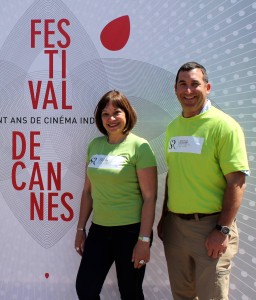Rated SR for Socially Relevant
Nora Armani, founding artistic director for the March 2014 film festival titled “Rated SR for Socially Relevant Film Festival New York,” talked to The Filmmaker Lifestyle recently after returning from Cannes and Rome. Armani advocates nonviolence in filmmaking through the development of “positive human stories.” She sees this as an alternative to the “proliferation of violence, crime, drugs and social ills in today’s movie industry.”

Nora Armani
”Personally for me,” Armani says, “non-violent story telling means not only the absence of obvious scenes of violence and excessively graphic scenes of murder, blood, physical assault, weapons, artillery, human mutilations and the like, but also the nagging and insistent style of story telling (with fast cuts in the editing and many camera angles) which attempts to make a film more ‘entertaining’.
“This type of filmmaking,” says Armani, “does not respect its audience, and instead of establishing dialogue or talking ‘to or with’ an audience talks ‘at’ it.” Armani believes this style of film is an insult to an audience’s intelligence.
“Of course,” she says, “there is the widespread belief in the film industry that this is what an audience wants, since these types of films sell the most tickets. So violent situations and sensationalism are favored over character driven, emotional human stories that deal with socially relevant issues in our daily lives. However, this belief is a misconception that is not based on facts.
“Audiences have become saturated with this type of film and are seeking more intelligent content worldwide. World Cinema has already been engaged in this alternative of ‘nonviolent storytelling’ for a long time. In these films the story unfolds in a natural way driven by the characters and situations they find themselves in, and not by violent and aggressive human interaction, whether or not arms and weaponry are involved.”
Why Focus on Nonviolence?
Nonviolence has a personal meaning for Armani. “This is important for me in memory of two very dear family members that were victims of violence through a hate crime.”
“Violence breeds more violence, and this creates a terrible vicious cycle. The film and audiovisual medium,” she says, “are the most powerful communications media nowadays, where virtually most humans have some form or type of screen attached to them, often at their fingertips, at any given time.
“The screen has become the means of getting the news, connecting with friends, learning, entertainment, and any and all forms of interaction. And while an image is worth a thousand words, it can easily impress things on our psyches. Movies, composed of many images, can have a far stronger and durable impact.
“Seeing a lot of violence promotes a ‘banality of evil’. It renders it commonplace. Its effects, however, are still devastating. Therefore, we need to break the chain at some point. We need to stop the promotion, proliferation and glorification of violence and crime in our society.”
Developing a Compelling Story
Nonviolent or otherwise, a story has to be compelling. “Indeed,” agrees Armani, “and compelling does not come about by how big the weaponry and the guns on the screen are, and how fast they fire, how many explosions a second we see on screen, and how many mutilated body parts are displayed along with the amount of graphic gore. In addition to violence there are other themes, such as prostitution and its glorification, drugs and their glamorization. These are not what make a story compelling in and of themselves.
“A story is compelling because of the characters that are in it and the social situations they find themselves in, whether it be despite themselves, or of their own doing.” Armani believes it’s all about how the characters solve their problems and come out improving their lives in an uplifting fashion. A compelling, character-driven story “… gives hope and develops aspirations in future generations that might eventually create a better world for our children.”
What makes a story compelling? “A mediocre story is one that relies heavily on sensationalism and visuals because probably it has nothing to say. A strong story grabs our emotions or intellect, depending on the approach, and creates compassion, love, hate, admiration, contempt or a plethora of other emotions that make us want to follow the plot. We want to see what happens next.
“A compelling story moves us, touches us, makes us think and reflect on issues, and certainly draws us in and stays with us even after we have left the movie theatre, or the screen. A mediocre story leaves us indifferent in time, even if to some people it might offer some mindless distraction for the brief duration of the screening.”
Unique Perspective

Socially Relevant Film Festival
Armani’s experience organizing film festivals gives her a unique perspective. “I have found that invariably films that have interested and moved me are those that deal with the human condition and tackle social issues. They are mostly character driven and mostly about good and kind people. How boring, some might say. Not so, because for good drama, conflict is always necessary, so these are films that are dramatically (or comically) driven and not boring at all. They address socially relevant issues in an entertaining and intellectually stimulating way. And of course let’s not forget that love and romance (with a twist) also fall into this category.
“When programming a festival I like to make sure that there is diversity: cultural, thematic, and stylistic diversity, to make for an intellectually grabbing and emotionally satisfying selection.”
Armani has organized many festival sidebars and guest-curated programs with various festivals: AFI, Kennedy Center, Silver Lake Film Festival, Paris Pompidou Centre, British Museum, ICA and Cine Lumière London, to name a few. She has also worked with film centers internationally in the UK, the USA, France, and Italy.
Young Filmmakers
We asked Armani what young filmmakers can do to make their films attractive to film festivals. “First and foremost, I would say writing. Before being a good filmmaker, it is important to be a good storyteller, and to have a feel for suspense, rhythm, development, build-up and well-rounded characters. Once this is mastered, the rest is easy, because technical people are there to help with their areas of specialization, to relay the message through the audiovisual medium. They are the ones that make the visuals come alive through the lighting, the camera angles, and all that make a film look good. As such they are a young filmmaker’s best allies. Most often the young filmmaker already has mastered these skills and follows a D.I.Y route. But if the story is not there, then the film is not compelling despite the stunning visuals it might have.
“So I would say young filmmakers need to first and foremost find out what makes a good story, and be attentive to what goes on around them. Listen, listen, listen and observe, observe, observe. That is where they get ideas and inspiration. Then they can learn about structure and cinematic language. The rest falls into place relatively easily.”
The Rated SR Festival

Nora Armani and Mike Camoin
”The festival will have two sections that are presented back to back, with a series of screenings over three days in Manhattan, then resuming for three more days in Upstate New York with Carol Ash, president of the Carey Center for Global Good, our partner organization. As the Founding Artistic Director, my responsibility is to discover and present films that have socially relevant content that could eventually merit the Rated SR label.
“However, in my selections I am not alone, as I consult with my colleagues. The upstate section, in addition to screenings, also has the Filmmakers Lab directed by Mike Camoin, co-founding partner, and it involves round table discussions, panels and meetings with filmmakers, producers, distributors, sales agents and other film industry professionals.
“We hope to offer filmmakers an international platform that gives their films the visibility they deserve, a visibility that might not be readily available to them through the normal distribution channels under the pretense of content that might not be commercial enough (though I don’t know who decides this…).
“If you offer audiences worthwhile content, they will gladly rush to the nearest screen, and render that content commercially viable. It is good business sense to treat your customers with respect and offer them good products with guaranteed value
for return business.
“Our goal is to demonstrate that Rated SR films CAN be commercially viable and even become huge successes. We wish to turn them into a trend instead of exceptions.”
Press release for the Rated SR film festival.
Festival Facebook page: https://www.facebook.com/RatedSRSociallyRelevantFFNY
Website (early submissions now open): http://pemart.org/events_festivals/rated_sr_-_socially_relevant_film_festival_new_york
